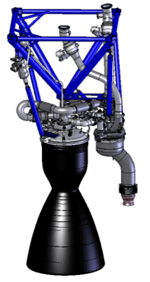SpaceX rocket successfully orbits on fourth attempt
Monday, September 29, 2008

Image: SpaceX.
Space Exploration Technologies Corporation (SpaceX) successfully launched and sent into orbit a Falcon 1 rocket, which was launched yesterday at 23:15 UTC from the Ronald Reagan Ballistic Missile Defense Test Site at Kwajalein Atoll in the Pacific Ocean.
This was the fourth attempt to launch this class of rocket, and the first vehicle to be successfully launched by private spacecraft developers. Previous attempts to launch this vehicle ended in failure due to engineering errors. Perhaps the most critical part of this flight occurred during the stage separation between the first and second stages of this rocket. In this flight, unlike previous attempts, the separation was without incident and the second stage maintained the planned trajectory into orbit. The rocket achieved an orbit at an altitude of 135 miles above the Earth after approximately ten minutes of powered flight.
The main technical difference between the third and fourth attempts was an adjustment in the timing between shutting down the first stage rocket engine and when the stage separation takes place. On the third attempt, the first and second stages collided into each other immediately after stage separation, which in turn damaged the second stage engine and resulted in a mission failure. For this fourth attempt, the stage separation occurred without any problem, and was greeted with loud cheers and applause by SpaceX employees who were watching a live telecast of the launch at the Hawthorne, California, USA manufacturing plant. This telecast was also released as a live video feed on the SpaceX website during the launch.
While other rocket companies have been successful at sending vehicles into orbit before, this is the first vehicle that has been designed from scratch without any components that came from previous government-sponsored vehicles. This is also the first privately developed liquid-fueled vehicle that has achieved orbit.
Elon Musk, founder, primary investor, and CEO of SpaceX, congratulated his employees upon reaching this milestone, saying "That was frickin' awesome! There's only a handful of countries on Earth that have done this. It's usually a country thing, not a company thing. We did it." He also said later on, "Definitely one of the best days of my life."
The payload of this rocket consisted of a 360 pound engineering test object made of aluminum, which was also fabricated by SpaceX in their Hawthorne manufacturing facility. Called the Ratsat, it was decorated with a logo of a rat by the SpaceX team that built it. Elon Musk estimates that it will remain in orbit for between five and ten years before burning up in the atmosphere.
Additional milestones accomplished by SpaceX on this flight included a successful deployment of parachutes on the first stage of this rocket, where SpaceX hopes to be able to recover this stage and be able to re-use that portion of the rocket on a future flight with some refurbishing. The second stage also performed an additional test by restarting its engine and moving to a higher orbit at between 300 to 450 miles (500 to 700 km) above the Earth with an inclination of 9.2 degrees, passing above the International Space Station during the maneuver.
"This is a great day for SpaceX and the culmination of an enormous amount of work by a great team," said Elon Musk, "The data shows we achieved a super precise orbit insertion—middle of the bull's-eye — and then went on to coast and restart the second stage, which was icing on the cake."
SpaceX is offering future flights of the Falcon 1 to the public for a price of about $7.9 million USD each, although Mr. Musk estimated that the total cost to test and develop this rocket, including the three previous failed launch attempts, came to about $100 million USD.
The next launch of the Falcon 1 is slated to happen sometime toward the end of the year, with a satellite that was manufactured and paid by the Malaysian government. Also scheduled for early next year is the maiden flight of the Falcon 9 rocket, which uses a multiples of nine rocket engines that are identical to the engine that was used in today's launch as well as many of the other components that were used on the Falcon 1. SpaceX is also under contract with NASA to develop a vehicle called the Dragon that will be supplying cargo to the International Space Station under the Commercial Orbital Transportation Services program. This spacecraft is also intended to eventually be capable of manned spaceflight.
Related news
- "SpaceX Falcon I rocket fails to orbit test satellite" — Wikinews, March 21, 2007
- "Mishap destroys SpaceX Falcon 1 after maiden launch" — Wikinews, March 24, 2006
- "SpaceX Falcon I launches from Kwajalein Atoll" — Wikinews, March 21, 2007
- "SpaceX delays Falcon 1 launch again" — Wikinews, February 21, 2006
- "Spacex cancels Falcon 1 launch until 2006" — Wikinews, December 19, 2005
- "SpaceX scrubs Falcon I rocket launch" — Wikinews, November 28, 2005
Sources
- Press Release: "SpaceX Successfully Launches Falcon 1 to Orbit" — SpaceX, September 29, 2008
- "Mission Status Center" — Spaceflight Now, September 28, 2008
- Press Release: "Latest Launch Updates" — SpaceX, September 28, 2008
- Aaron Rowe. "SpaceX Did It -- Falcon 1 Made it to Space!" — Wired Science, September 28, 2008
- Chris Bergin. "Space X’s Falcon I launch success on fourth attempt" — NASA Spaceflight.com, September 28, 2008
- Alan Boyle. "Low-cost rocket finally gets to orbit" — MSNBC, September 28, 2008
- "SpaceX launches 1st commercial rocket into orbit" — Associated Press, September 28,2008
External Links


